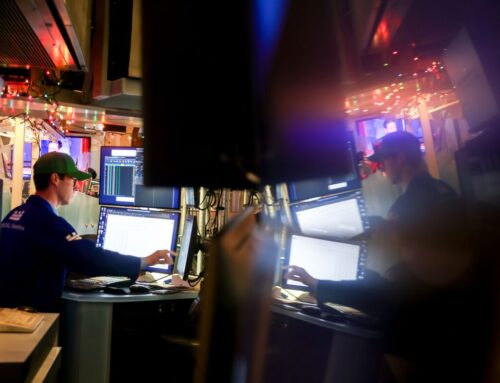USF’s Student Green Energy Fund projects make a lasting impact on campus sustainability
April 3, 2025

USF’s Student Green Energy Fund financed new lights in the Collins Boulevard Parking
Facility. [Photo by Paul Guzzo, University Communications and Marketing]
By Paul Guzzo, University Communications and Marketing
When walking the Tampa campus, it seems nearly impossible not to stumble upon a Student
Green Energy Fund project that has become an integral part of University of South
Florida life.
Since its inception on the Tampa campus, more than 60 projects have been funded for about $20 million. Examples include electric vehicle charging
stations, solar umbrellas with USB charging stations, hydration stations, about 100
trees and solar panels on building roofs.
“Through the Student Green Energy Funds, students, faculty and staff can help USF
to become a more sustainable campus through energy reduction, decreasing our carbon
footprint, and promoting renewable energy options,” said Jay Souza, USF assistant
vice president of student success and chairman of the fund’s council.
Since 2012, USF has been allocating $1 per credit hour to projects that can reduce
and eventually eliminate greenhouse gas emissions.
The St. Petersburg and Sarasota-Manatee campuses have their own set of initiatives.
For an alternative mode of transportation, St. Petersburg’s Green Energy Fund recently
funded one dozen new bikes that students can check out through Campus Recreation.
Sarasota-Manatee recently installed two electric vehicle charging stations in its
south parking lot.
Proposals must include the cost, environmental benefits and information detailing
how a project will be completed and then maintained. They are then approved or denied
by the Student Green Energy Fund Council made up of six students and six USF employees.

A treadmill creates electricity on the Tampa campus [Photo by Paul Guzzo, University
Communications and Marketing]

Sarasota-Manatee’s electric vehicle charging station [Photo by Marc Masferrer, University
Communications and Marketing]

Bikes available to St. Petersburg campus students [Photo by Cliff McBride, University
Communications and Marketing]
Each campus’ student projects must have a campus sponsor, typically a department or
professor to lend expertise, but a student should head the endeavor – a process designed
to further mold them into leaders.
“Students gain tremendous hands-on experiences with project and proposal development
as they lead these projects,” Souza said. “They need to work with stakeholders, various
departments and determine accurate budget needs.”

Miguel Goni Rodrigo, María Teruel Echeverría, Patricia Zamora Diaz and Mauro Sempere
Sanz at Magnolia Fields [Photo courtesy of Mauro Sempere Sanz]
A group of engineering students led by Miguel Goni Rodrigo, an associate professor
in the Department of Mechanical Engineering, investigated several ideas for the Tampa
campus in search of the one that they deemed to be the most cost and environmentally
efficient.
They researched and spoke to USF officials about purchasing solar-powered car ports,
solar panels for buildings and treadmills and stationary bikes that power the Campus
Recreation Center.
The Tampa campus’s USF Recreation and Wellness department then recommended that the
group investigate ways to save the amount of energy used at Magnolia Fields.
The fund’s council approved the group’s proposal to replace the intramural sports
fields’ halide lamps with 54 bulbs that boast energy efficient LED technology.
That “is one of the most basic measures that should be done because it’s easy, not
costly and brings lots of savings,” said group member Mauro Sempere Sanz who is majoring
in mechanical engineering.
The purchase and installation cost $332,375. The lights use 24,000 fewer kilowatt
hours each year, last longer and require less maintenance.

The Marshall Center’s automated floor cleaner [Photo courtesy of David Timmann]
“We thought we would pitch an idea and that was it,” said biomedical engineering major
Patricia Zamora Diaz, a member of the group that also includes María Teruel Echeverría,
who is majoring in industrial engineering. “It was a lot more than that. We learned
a lot along the way. It was fulfilling to see it through to completion.”
Employees can propose ideas on their own too.
David Timmann, associate director for operations of the Marshall Student Center, recently
purchased an automated floor scrubber that converts water into bubbles rather than
using chemicals.
“It has no toxicity on the environment,” Timmann said of the scrubber, for which the
fund covered two-thirds of the total cost.
If future students and employees need other ideas, student Morgan Mathews’ project
can provide those too.
The fund awarded her funding to compile two connected reports.

Morgan Mathews
For the first, the environmental science and policy major, who is minoring in biology
and Spanish, performed a holistic campus-wide assessment of waste management practices.
With the help of USF sustainability manager Suchi Daniels, she engaged with campus
stakeholders to envision possible long-term improvements. Those were compiled in a
second report.
Ideas include corporate food vendors using reclaimable to-go containers and a campus
thrift store.
“Think of it like a blueprint,” Matthews said. “It provides a foundation for what
can be done. Hopefully, future students take the ideas to the Student Green Energy
Fund.”
Learn more about how to submit a proposal for a project funded by the USF Student
Green Energy Fund.
Search
RECENT PRESS RELEASES
Related Post




